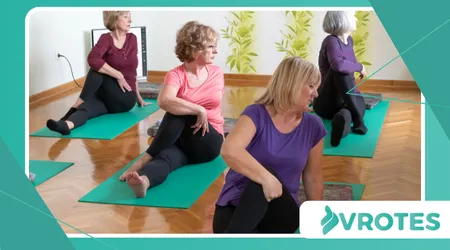Adapting Your Yoga Practice for Hormonal Balance in Midlife

Navigating the shifts in hormonal balance in midlife can feel like an unpredictable journey.
Anúncios
Many women experience a range of symptoms, from hot flashes and sleep disturbances to mood swings and changes in energy.
While these changes are a natural part of aging, they often disrupt daily life. Fortunately, ancient practices like yoga offer a gentle yet profound path to managing these transitions with grace and resilience.
Understanding Midlife Hormonal Shifts
Midlife brings significant hormonal fluctuations, particularly decreases in estrogen and progesterone.
These shifts impact nearly every bodily system, affecting metabolism, bone density, and even cognitive function.
Anúncios
The symptoms vary widely among individuals, making personalized approaches essential. Understanding these underlying changes helps us tailor effective strategies.
Yoga: A Holistic Approach to Hormonal Harmony
Yoga, more than just physical exercise, is a holistic system connecting mind, body, and spirit.
Its practices, including postures (asanas), breathing techniques (pranayama), and meditation, work synergistically.
This integrated approach can help mitigate the discomfort associated with hormonal changes, fostering a sense of inner calm. It’s about finding equilibrium in a time of flux.
The Power of Breath (Pranayama) for Regulation
Pranayama is arguably one of yoga’s most potent tools for hormonal balance in midlife. Conscious breathing directly influences the autonomic nervous system.
Read here: Hormone-Free Strategies for Easing Vaginal Dryness
This system controls involuntary bodily functions, including hormone production.
Deep, rhythmic breathing can shift us from a stressed “fight or flight” state to a calmer “rest and digest” mode.
Consider Nadi Shodhana, or alternate nostril breathing. Practicing it can balance the hemispheres of the brain and calm the nervous system.
This technique promotes mental clarity and emotional stability. Regular practice can genuinely make a difference.

Tailoring Asanas for Menopausal Bodies
Certain yoga postures are particularly beneficial for midlife women. Focus on poses that support the endocrine system, which produces hormones.
Gentle inversions, for example, can stimulate blood flow to the thyroid and adrenal glands. These glands play crucial roles in hormonal regulation.
Restorative poses, like Supported Supta Baddha Konasana (Reclined Bound Angle Pose with support), open the hips and groin, releasing tension.
Read more: Menopause and Memory: Foods That Support Cognitive Function
Such poses encourage deep relaxation and reduce stress. Stress is a significant disruptor of hormonal harmony.
Weight-bearing poses, such as Tadasana (Mountain Pose) or Virabhadrasana (Warrior I and II), help maintain bone density.
This is crucial as estrogen decline can lead to osteoporosis. Incorporating these strengthens the skeletal system.
Cultivating Calm Through Meditation
Meditation is an indispensable component of a yoga practice for hormonal balance. The mind’s state profoundly influences the body’s chemistry.
Chronic stress, a common feature of modern life, exacerbates menopausal symptoms. Meditation offers a sanctuary.
Just as a tumultuous ocean needs time to settle and reveal its clear depths, so too does a busy mind.
Through meditation, we allow the mental chatter to subside. This practice fosters a sense of inner peace.
Regular meditation can lower cortisol levels, the primary stress hormone.
High cortisol interferes with other hormone production, including estrogen and progesterone. Even short, consistent meditation sessions yield benefits.
A Midlife Woman’s Journey with Yoga
Consider Sarah, 52, who struggled with intense hot flashes and insomnia. She felt constantly on edge, her patience wearing thin.
Traditional remedies offered little relief. Sarah reluctantly tried a gentle yoga class focused on restorative practices. Initially skeptical, she committed to three sessions a week.
Within two months, Sarah noticed a remarkable change. Her hot flashes became less frequent and less severe.
++ Best Nuts and Seeds for Hormone Health
She began sleeping more soundly, often through the night. The biggest surprise was her improved mood and newfound sense of calm.
Yoga didn’t eliminate her symptoms, but it made them manageable, allowing her to reclaim her life.
This is not an isolated story. Many women find similar relief. The key lies in consistency and adapting the practice to individual needs.

The Importance of Listening to Your Body
Midlife bodies respond differently to physical activity. What worked in your twenties or thirties might not serve you now.
Flexibility, energy levels, and even joint health can change. It’s crucial to listen intently to your body’s signals.
Avoid pushing through pain or discomfort. Modify poses as needed, using props like blankets, blocks, and bolsters.
These tools support your body, allowing for deeper relaxation and safer alignment. Gentle movements are often more effective.
Nourishing the Hormonal System Beyond the Mat
Yoga is a powerful pillar, but true hormonal balance in midlife requires a holistic approach. Nutrition plays a vital role.
Prioritize whole, unprocessed foods, healthy fats, and adequate protein. Hydration is also paramount for cellular function and detoxification.
Limiting processed sugars and excessive caffeine can significantly reduce symptom severity.
These substances can exacerbate hot flashes and disrupt sleep. Small dietary changes can make a big difference.
The Emotional Landscape of Midlife
Midlife is not just a physiological transition; it’s an emotional one too. Women often face new family dynamics, career changes, or the “empty nest” syndrome.
These emotional stressors intertwine with hormonal changes, intensifying symptoms. Yoga provides a safe space for processing these emotions.
Through mindful movement and meditation, you can cultivate emotional resilience. Yoga teaches us to observe our thoughts and feelings without judgment.
This self-awareness is invaluable during times of change. It helps us navigate the emotional currents.
Creating a Sustainable Yoga Practice
Consistency, even in small doses, is more beneficial than sporadic intense sessions. Aim for short, regular practices, perhaps 15-20 minutes daily.
Or dedicate longer sessions a few times a week. The goal is to integrate yoga seamlessly into your life.
Find a qualified yoga instructor who understands the specific needs of women in midlife.
An experienced teacher can offer personalized modifications and guidance. Online resources also provide flexibility and variety.
The Science Behind Yoga’s Efficacy
While the anecdotal evidence is compelling, scientific research also supports yoga’s benefits.
A systematic review published in Menopause in 2023, analyzing multiple studies.
Concluded that yoga interventions can significantly reduce hot flashes, night sweats, and sleep disturbances in menopausal women.
This robust evidence strengthens yoga’s position as a valuable complementary therapy.
Table: Yoga Practices for Midlife Hormonal Balance
| Yoga Practice Category | Benefits for Hormonal Balance | Examples of Practices |
| Pranayama (Breathwork) | Calms nervous system, reduces stress hormones, improves sleep | Nadi Shodhana (Alternate Nostril Breathing), Ujjayi (Ocean Breath) |
| Asanas (Postures) | Supports endocrine glands, improves circulation, maintains bone density | Supported Bridge Pose, Legs-Up-The-Wall, Gentle Twists, Warrior Poses |
| Meditation/Mindfulness | Lowers cortisol, reduces anxiety, enhances emotional regulation | Body Scan, Loving-Kindness Meditation, Guided Visualization |
| Restorative Yoga | Deep relaxation, reduces fatigue, soothes an overactive nervous system | Supported Supta Baddha Konasana, Child’s Pose with bolster |
Beyond the Physical: The Community Aspect
Joining a yoga class can also provide a vital sense of community. Sharing experiences with other women navigating similar challenges fosters connection and reduces feelings of isolation.
This social support is a powerful antidote to stress. It reminds us we are not alone in this journey.
Finding Serenity Amidst Chaos
Imagine Elena, a busy executive in her late 40s. Her demanding job, coupled with early perimenopausal symptoms like brain fog and anxiety, left her feeling overwhelmed.
She felt like she was constantly running on an empty tank. She decided to try a weekly Yin Yoga class, which focuses on long-held, passive stretches.
Initially, lying still was challenging for her active mind. But over time, she found profound stillness.
Elena discovered that this dedicated hour allowed her to completely disconnect from work pressures and reconnect with herself.
The deep stretches released physical tension, and the quiet contemplation brought mental clarity. This weekly sanctuary became indispensable for her hormonal balance in midlife and overall well-being.
Embracing the Journey with Compassion
Midlife is a powerful time of transformation and recalibration. It invites us to slow down, reflect, and re-evaluate our priorities.
Yoga offers a compassionate framework for this process. It encourages self-acceptance and patience.
Are we not all deserving of tools that empower us during such significant life changes?
By integrating a thoughtful yoga practice, you’re not just managing symptoms; you’re cultivating a deeper connection to your body’s wisdom.
This journey can be one of empowerment and self-discovery, leading to greater well-being and a more harmonious midlife experience. It is a time for growth, not simply decline.
Frequently Asked Questions
How often should I practice yoga for noticeable results in hormonal balance?
Consistency is key. Even 15-20 minutes of daily practice can be effective. If time is limited, aim for 3-4 times a week. Longer sessions, when possible, enhance the benefits.
Are there any types of yoga I should avoid during menopause?
High-intensity or extremely vigorous styles might be too stimulating for some women, especially if experiencing hot flashes or fatigue.
Listen to your body and prioritize gentle, restorative, or Hatha yoga styles. Avoid overheating or overexertion.
Can yoga help with weight gain often associated with midlife?
While yoga alone isn’t a magic bullet for weight loss, it can support healthy weight management.
By reducing stress, improving sleep, and increasing mindfulness around eating habits, yoga indirectly assists. Building muscle through certain poses also boosts metabolism.
Do I need prior yoga experience to start?
Absolutely not. Many yoga studios offer beginner classes. Start with gentle or restorative styles. Focus on listening to your body and moving with breath.
There are also numerous online resources for absolute beginners.
What if I have joint pain or other physical limitations?
Yoga is highly adaptable. Inform your instructor about any limitations. Use props generously.
Focus on modifying poses to suit your body, rather than forcing yourself into a specific shape. Chair yoga is an excellent option for those with significant mobility challenges.
Can men benefit from yoga for hormonal balance too?
While this article focuses on women’s midlife, men also experience hormonal shifts (andropause).
Yoga’s stress-reducing, circulation-boosting, and strength-building benefits are universal and can support men’s hormonal health as well.
++ Top 10 Yoga Practices for Balancing Your Hormones Naturally
